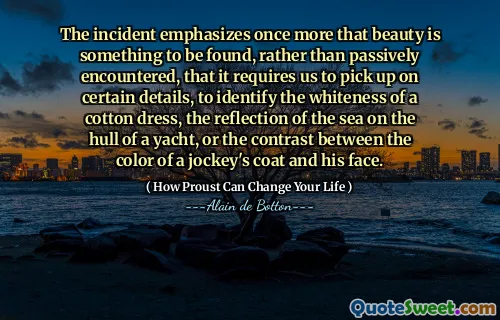
The incident emphasizes once more that beauty is something to be found, rather than passively encountered, that it requires us to pick up on certain details, to identify the whiteness of a cotton dress, the reflection of the sea on the hull of a yacht, or the contrast between the color of a jockey's coat and his face.
This quote underscores a profound truth about our perception of beauty: it is not simply something that we stumble upon passively but rather something that demands active engagement and attention to detail. In a world saturated with superficial visual stimuli, recognizing beauty often requires a mindful observation of the subtle intricacies that might otherwise go unnoticed. For instance, the whiteness of a cotton dress may seem straightforward at a glance, but when perceived with intentional focus, it reveals a certain purity and simplicity that evokes silent admiration. Similarly, the reflection of the sea on a yacht's hull can be appreciated as a transient dance of light and color, which may only be appreciated when one pauses and truly looks. The contrast between a jockey's coat and face is another example, illustrating how color and expression combined tell a story or evoke emotion. Such details elevate our experience from a passive glance to an active discovery, inviting us to slow down and cultivate our perceptiveness. This process encourages a deeper appreciation of the world’s complexity and artistry, whether in nature, art, or everyday scenes. Essentially, beauty is a dialogue we participate in actively, shaping our perception through attentive sensitivity and a willingness to observe beyond the surface, which makes life richer and more meaningful.
( How Proust Can Change Your Life ) - author: '---Alain de Botton---'






